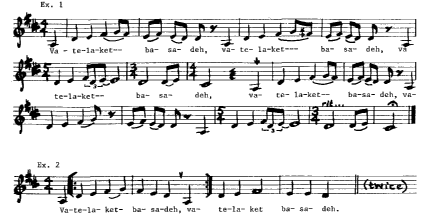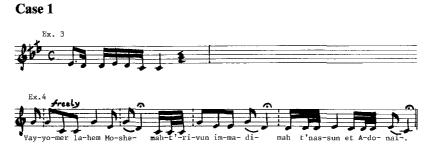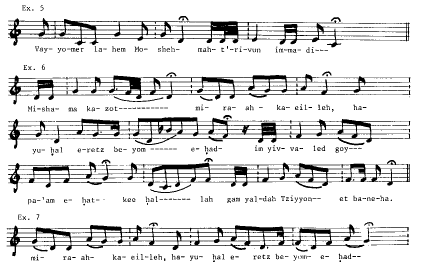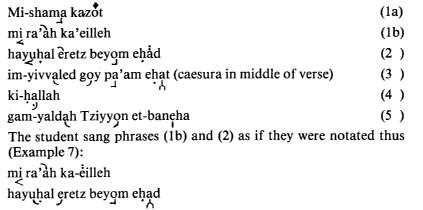
Canadian Journal for Traditional Music (1982)
ERRORS IN TRANSMISSION AS INDICATORS OF EAST-WEST DIFFERENCES: A STUDY OF JEWISH MUSIC IN TORONTO
As every teacher knows, the mistakes that students make are always more interesting than exercises completed as the teacher expects. Thus in the course of teaching Jewish songs to children in Canada, I have paid attention to certain kinds of "error," by which I mean the way in which characteristic melodic features in the original were spontaneously replaced by more "western-sounding" ones. The way in which these children, born and educated in a western culture, learnt musical material of Middle Eastern origin may shed some light on differences between music typical of these two cultural regions.
The observation of error has long been recognised as an important source of knowledge.' An application of this idea to music was made by Chenoweth,2 who pointed out the usefulness of teaching songs to natives as a test of the teacher's understanding of the native music system.
In this article I will discuss the way in which children learnt two rather different kinds of songs: a short song originating in the Israeli Yemenite community, and the cantillation of the Bible.
Part 1: A Yemenite Song
The melody in this study was taught by an Israeli-born teacher, of Yemenite family origin, to a class of about twenty-five Fourth Grade students in a Toronto Jewish school. The typical student in this class has English-speaking parents but has attended Hebrew immersion classes since Kindergarten, and has been exposed to traditional melodies of the Canadian and Israeli Jewish communities from early childhood. The song (Example 1) was taught by repetition by the teacher, who had received no musical training. The teacher learnt the song from hearing performances of the Israeli "Inbal" theatrical troupe which specializes in presenting artistic versions of folk and folk-like material of Jewish Oriental communities, particularly that of the Yemenite Jews. This is of interest to the present study, since Yemenite-Jewish music has certain features (such as regular meter and diatonic tendency) which are lacking in other Oriental styles, but which resemble features of Western European folk music. This has encouraged the popularization of Yemenite music amongst Western Jewish communities.3 The teacher admitted that the song as she remembered it was only the refrain from a longer song, and was not necessarily "correct,"

but for the purposes of the study this is not relevant.
The children sang the song as given in Example 2 and the teacher made no attempt to encourage the children to sing closer to her original.
Comparison of the two Versions
The two versions differ in the following respects:
1. The original has many short, unstressed notes (here notated as eighth notes) which the copy lacks.
2. The unexpected ending on what appears to be the leading tone, or semitone below the tonal centre, has been changed to a very firm cadence on the tonic.
3. The irregular rhythm of the original has been smoothed out, most of the song being sung in quarter notes. This is most noticeable when comparing the last three measures of the original with the last two measures of the copy.
4. The phrase ending on e' (measure 5), i.e. the apparent super-tonic, has been changed so that it ends by continuing the ffl', i.e. a tone harmonically related to the tonic d'.
We may now see if we can explain some of these differences as being due to cultural differences between Oriental and Western music.
Oriental Features of the Original Song.
1. The tendency to employ unstressed notes, using pitches adjacent to those of the preceding or succeeding stressed note, is a characteristic of Arabic music and is part of the overall feeling for ornamentation. (In a Western context, such ornaments would sound like "non-harmonic tones" but this term cannot be used in the absence of harmony.) In Example 1 the use of the note d' in anticipation (measures 2 and 4) gives a motif that occurs in much Arabic music (cf. Example 3).4 This use of unstressed notes results in phrases that move in short steps and have a "centric" pattern, i.e. the melody moves up and down from a tone in the middle to which it constantly returns. These are two features that Sachs has described as typical of Oriental-Jewish song.5
It is possible that the students ignored the eighth note f#' in measure 1 and used the f #'in measure two as a stressed note (hearing it as an implied harmony note), thus ignoring the e' before it to give a smooth movement down to d'. Note that the teacher weakened the last f# 'in measure 3 and omitted it altogether in measure 10.
2. Some Arabic modes have a half-tone and three-quarter tone step between the first two degrees, which is not found in modern Western music.6 As a result, many tunes in such modes end by a semitone fall to the final note. We cannot confidently assign the melody of Example 1 to such a mode, but we may at least note the very striking cadence of a halftone fall to the final note.
3. The rhythmic and pitch changes made in measure 5 of the students' version may stem from their unfamiliarity with the kind of irregular melody found in Oriental song.
The final form of the song as sung by the students consists of phrases with even meter and a feeling of implied harmony in the key of D Major. The melody, outlining a triad, could easily belong to a family of melodies found throughout Western Europe, embracing such examples of the carol Puer nobis nascitur7 and the German folksong Ich bin so lang bei Dir nicht g'west, whose homely (to a German) features may have encouraged Bach's quotation of this song in the Goldberg Variations.
The metamorphosis of the melody observed in the study may be explained by the subconscious rejection of elements felt to be alien to the native music system of the students. This is of particular interest since they had been exposed for at least four years to what they regard as traditional Jewish music, while the teacher was also concerned with the transmission of ostensibly Jewish song.
The question must be asked whether these differences are more the result of group imitation of a solo than of cultural differences between teacher and students. The differences may also be due to a natural tendency of children to simplify rhythm. To resolve these questions we would need to compare an Oriental class of students with a Western class. In this respect, the case described here is more a preliminary observation than experimentally controlled research. We can hear examples8 in which Oriental groups repeat "maccurately," i.e., they make variations, as frequently omitting ornaments as adding them. These variations made by different individuals are combined heterophonically.
While it is true that the supression of ornaments is found in Oriental groups, it is nonetheless striking that in the case described here, a "Yemenite-sounding" tune has been converted into a "Western-sounding" one.
Part 2: Bible Cantillation
I wish to describe now some cases in which Western students experienced difficulty in copying traditional Bible chant.
The system by which the Hebrew Bible text is chanted crystallized in Palestine by the tenth century. The particular melodic motifs used in the present study are those that evolved in later centuries in Eastern Europe and were subsequently brought to North America. The chants of Oriental Jews differ in certain particulars.9
The students observed in this study were twelve-year-old boys, all educated in Toronto Public Schools, preparing for their barmitzvah ceremony. This involves the public chanting of the scriptural lesson for that day when the boy celebrates his legal majority at age thirteen.
Recognizing that not all students are equally able to sing in public, Jewish law does not actually require the barmitzvah boy to chant scripture. Most families, however, will insist that he does, even if the skills involved (ability to sing and to read Hebrew) are lacking. The barmitzvah student himself is encouraged by his peers to undertake the task, which in many cases where the student is unfamiliar with Jewish customs then acquires the atmosphere of an initiation rite — mental (rather than physical) pain followed by celebration to mark the successful passage through an unpleasant ordeal.
When taught systematically, Bible cantillation is not particularly difficult or esoteric. A student who has been made familiar with Jewish ritual and prayer since early childhood, and who has some singing ability, will experience no difficulty or tension in learning to chant even the longest passages (up to about five chapters for the most able).
The fact that weak students will persevere in their barmitzvah studies as a self-imposed test of determination means that the teacher is able to insist on a much higher degree of accuracy than would be demanded if teaching similar subjects (reading or singing) in a normal school environment. This in turn helps to ensure that the traditional style of cantillation is not changed or simplified for the benefit of the student.
When chanting from the Hebrew Bible, attention is paid to the accent marks (te'amim) given in the traditional text. These accents indicate three things: the syllable to be stressed, punctuation, and the melodic contour of the chant. The latter function is of the most interest here. Each of the twenty or so signs is associated with a particular motif. When chanting the text, the reader sings each word to the appropriate motif indicated by the accent given for that word.

For example, in Example 4 the words lahem and mah-t'rivun have the same sign above them and are therefore sung to the same motif. Example 4 uses a total of five motifs, each with its own sign.
I shall quote examples of mistakes made by two different students when learning to chant the melodies for their barmitzvah scriptural lessons. In both cases, the students lacked the reading skills to distinguish the individual accents on the printed page of Hebrew text, and relied mainly on learning the melodies as a whole, using unusual words or melodic phrases as their main guides. In all cases the motivation of the student was such that he was ultimately able to correct his mistakes, even though this might take several weeks.
The student listened to the teacher singing the following text, part of Exodus 17:v.2 (Example 4):
Vayyomer lahm Moshé mah-t'rivn immadi mah-t'nassun et-Adonai
The student repeatedly sang this as if it were accentuated as follows, after which he stalled (Example 5):
Vayyomer lahem Moshé mah-t'rivun immadi
This may be explained if we assume that the student is thinking in terms of balanced phrases, rather than individual melodic motifs. Thus after the first phase of three words, the student sang the next two words as a balancing phrase rounding off the whole to finish the sentence. This left him with two hyphenated words remaining, which he was unable to sing at all.
Case 2
This example has a melodic system different from that in the first case since it uses a text from the Prophets rather than the Pentateuch (different Biblical books are chanted to different melodic motifs).
The teacher sang as follows, the entire verse or Isaiah 66:v.8 (Example 6):



This case involves a mistake extending over four signs rather than two as in the previous cases, but it can be explained on the same principle of expecting balanced phrases. The student appears to expect the whole verse to consist of four balanced phrases, arranged in two groups of two. The phrase sung incorrectly is a section in the first half of the verse (numbered (2) above); the student ignored its melodic features (musically more or less a repetition of the preceding phrase) and sang it as the expected balancing phrase, which is what phrase (3) above sounds like. He stalled when attempting to sing the words of phrase (3) which he had already managed to learn. Expressed diagramatically, we may imagine that the student could not fit the phrase hayuhal eretz beyom chad (phrase (2) above) into a pre-conceived symmetrical structure like this:
Many writers'0 have commented on the distinction between melodic construction in "Oriental" music and its construction in modern Western music. The continual re-arrangement of short motifs is characteristically "Syro-Palestinian";11 while modern Western music is based on contrasting passages with different melodies. In this context we can see how traditional Bible cantillation as used today in North America, even if its intervals and cadences have been affected by those of Western music, is based on the SyroPalestinian system of "the endless variation of basic motifs."12
This may explain the difficulties experienced by the students in the cases cited above. The students appear to have been applying their experience of melodic construction (involving balanced phrases) to a text with irregular phrase lengths. There is another way in which weak students seem to rely on a whole melody as their model: in the first few lessons they have great difficulty in singing even the shortest phrases. It is as if the student is aware that the motifs themselves are not found in his everyday musical experience, and this makes them hard to assimilate. The student has to learn a whole phrase or verse, so that each new motif is felt as belonging to a larger entity. The teacher may use this to his advantage, at first teaching those particular phrases that have a clear symmetry (or "tune"), so that the unfamiliar intervals are fixed in the beginner's memory; but this method works against the teacher when the text has an irregular pattern of stresses. Ernest Newman, in a review of Bloch's music, described this conflict between Eastern and Western melody, referring to the replacement by European "measured" song of "Oriental" "non-measured" song, and "the universal acceptance of the two- or four-bar phrase as the only norm for melody."13
Conclusions
The study of the changes in music which occur during its transmission, as described here, may help us to identify musical traits which are characteristic of different cultures. It may also show us how unfamiliar music is absorbed by a culture.
MerriamM has described how, on a wider scale, musical features that are alien to the host culture will either die out or be maintained only as a private tradition. In the case of the Yemenite song, the children were unable to absorb the original material; in its original form it remained part of the tradition only of the teacher, and its survival in the host culture will only depend on her success in its preservation. In the case of the Bible cantillation, it is understood by teacher and student that ritual demands very close agreement between the teacher's original and the student's copy. Given this motivation, and extra effort by teacher and student, the music, with its "Oriental" features, survives in the Occident where its practitioners are culturally at home.
Beth Emeth Bais Yehuda Synagogue
Downsview, Ontario
© Canadian Journal for Traditional Music